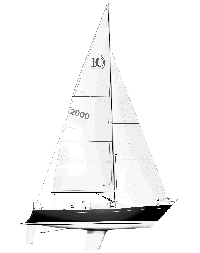Tartan T-10
Offshore One-design
If you go back 25 years you'll remember that the J/24 told the sailing world, loud and clear, that the IOR was not the way to produce the most boat speed for a given LOA. IOR boats were initially tippy, broad beamed, relatively heavy, narrow in the ends and had disproportionally large foretriangles. This combination produced boats that, while fast upwind, especially in light air, were not much fun reaching and running in a breeze where their hull form limited them to displacement speeds and a rare, white-knuckled burst of surfing.
These tendencies were accentuated by the fact that sailmakers had us all convinced we needed to fly a blooper to gain that extra downwind speed. The only effective way of keeping a blooper filled was to sail the boat low, with the apparent aft of 160 degrees. Sailing low and at hull speed, the IOR boat was perched on its volume-challenged ends. The result was a boat that could round up or down at a moment's notice. Kind of like riding a football.
Rounding up is fine. Rounding down is another thing. With the spinnaker pole dragging through the water, the boom pointing skyward and the crew scrambling to the new high side, the skipper would usually give a command of "Aaaaaaaeeiii!" There had to be a better way to sail.
The S&S-designed Tartan Ten was introduced as a one-design that addressed the ills of the IOR type. The hull was narrow with plenty of volume in the ends, including a stern that was much broader than typical IOR types. The rig was a small foretriangle fractional rig and the boat had a D/L of 136 instead of the 190 of a typical IOR half-tonner class. It wasn't long before Tartan was building hundreds of Tens (more than 400) and the boats were being raced under every conceivable handicap rule (IOR excepted) and doing well. In 1999 there were still 35 boats competing for the North American Championships, and the class expects 45 boats at this year's nationals.
On the surface the biggest design change for the new Ten is the addition of a cabintrunk. This trunk doesn't intrude into the large cockpit area of the original. Certainly this large cockpit is one of the best selling-features of this design. The transom has been modified, without increasing the LOA, to include a short swim step. The mast, boom, keel and rudder are all interchangeable with the original Ten components. Among the 34 changes listed in the brochure are longer bunks, an enclosed head and a redesigned galley. The Ten has always been pretty Spartan below.
If you look at the current one-design classes you will see plenty of features that were used on the original Tartan Ten. The rig uses swept spreaders, no runners and a working jib. (Genoas are forbidden when racing one-design.) The advantage the new Ten has is that there is already a very well-established and active one-design class. The plug for the new Ten was the current North American champion Dora. It will be fun to watch and see if the new boats compete equally with the original boats.

Comments